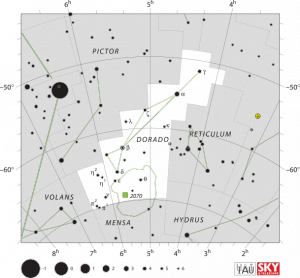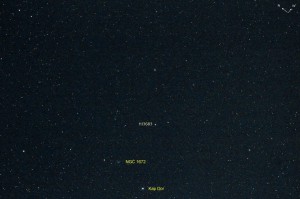HJ 3683 (04 40 17.72 -58 56 39.5). “Very fine”, noted John Herschel from South Africa in 1836 when he first laid eyes on this pair of stars and gave them both magnitude 8. The WDS catalogue says they are 7.3 and 7.5 but the main interest lies in the nature of the apparent orbit of this 326 year binary.
The high inclination means that motion is restricted to a narrow range of position angles and so mainly manifests itself in separation, whilst the very high eccentricity (0.95) means that the maximum separation is 4″.3 whilst the minimum is only 0″.03 which, given the Hipparcos parallax of 32.77 mas, indicates that the two stars are only 3.7 AU apart at periastron but 144 AU apart at apastron. When at their nearest separation the position angle changes by 1 degree per day, almost 5 times faster than that managed by the two components of gamma Virginis at periastron.
The pair is currently at 3″.7 and so is an easy object for the small telescope. Gould with 175-mm calls both stars yellow and the pair can be found about three degrees south and slightly following alpha Doradus.
(ref : Bob Argyle – Webb Deep-Sky Society)
The table below is from the Washington Double Star Catalog and gives the details of the system.
| WDS | RA | DEC | 1st Ob | Last Ob | Pa 1 | Pa 2 | Sep 1 | Sep2 | m1/m2 |
| HJ3683 | 04 40 17 | -58 57 | 1835 | 2009 | 81 | 90 | 3.0 | 3.7 | 7.3/7.5 |


